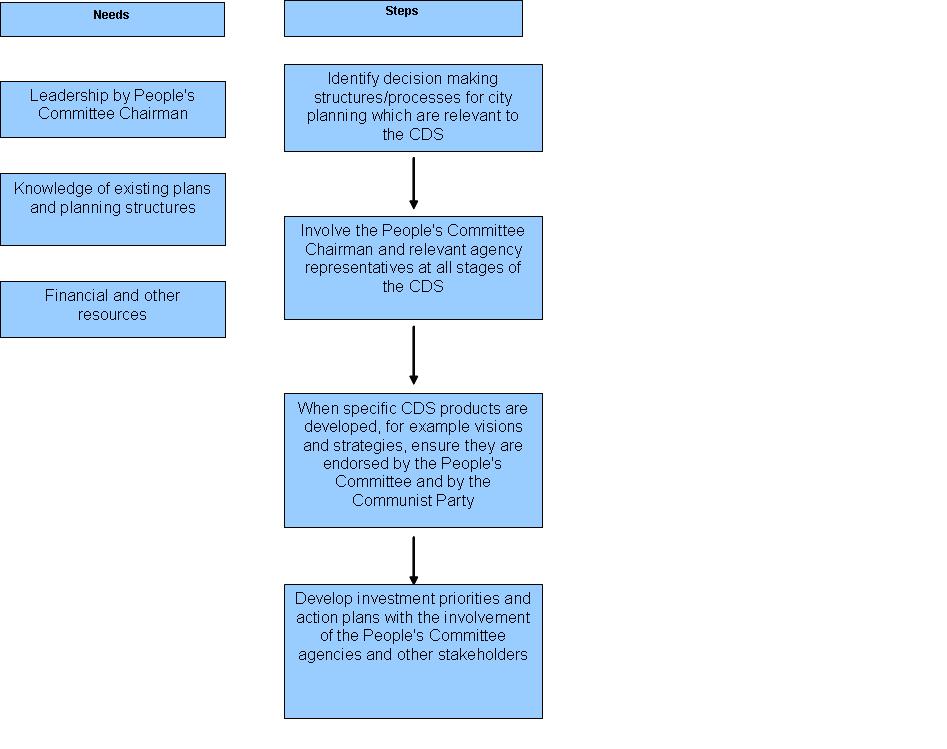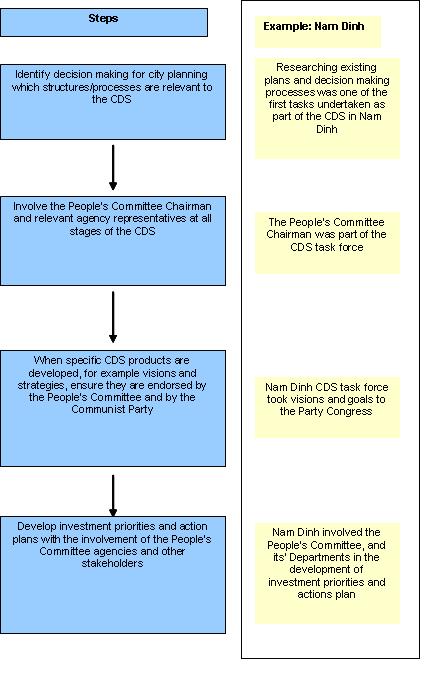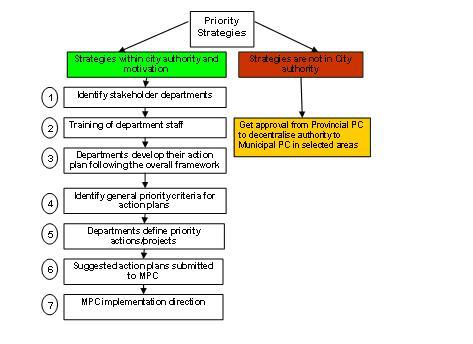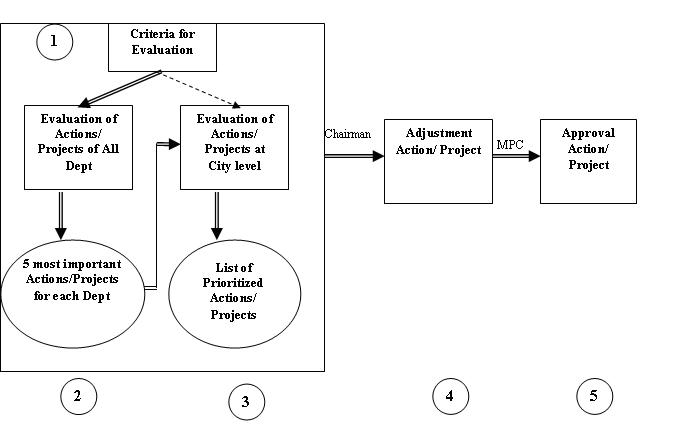GUIDE TO CDS IN VIETNAM FINAL DRAFT FOR SDC_en
BusinessKey principles for Good Practice in ‘Implementation and Integration’
- Base initial components of CDS (assessments, visions, strategies) on existing national, regional, provincial and city plans.
- Involve the main planning sections and departments of the city and province in the CDS as it is prepared (DPI, DOC etc).
- Develop organisational mechanisms for preparation of all or parts of the CDS which can generate greater integration, for example joint working sessions.
- Refer outcomes of the different building blocks step by step back to the decision making structures of the city, in particular the PC and People’s Council.
Key Components of ‘Implementation and Integration’
- Identify decision-making structures/processes for city planning which are relevant to the CDS.
- Involve the People's Committee Chairman and relevant agency representatives at all stages of the CDS.
- When specific CDS products are developed, for example visions and strategies, ensure they are endorsed by the People's Committee and by the Communist Party.
- Develop investment priorities and action plans with the involvement of the People's Committee, agencies and other Stakeholders.
How to do ‘Implementation and Integration’
Framework
There are many ways to approach implementation and integration and your approach will depend on how things work in your city (in terms of planning and how agencies coordinate work), the available budget for this part of your CDS and the extent to which the CDS vision and action plan aligns with existing city planning structures and strategies. The CDS vision and strategy will need to be closely aligned with existing planning structures.
To help you develop the most appropriate implementation and integration strategies for your CDS, the following diagram outlines a framework of ‘needs’ and ‘steps’. These ‘needs’ are pre-requisites for successful integration of a CDS. They include support from the People’s Committee, knowledge of the existing institutional landscape in your city and financial and other (for example human) resources. The ‘steps’ outline a number of stages of the integration process. They will guide you through the necessary procedures to implement and integrate your CDS.
Framework
,
- Identify decision-making structures/processes for city planning which are relevant to the CDS.
- Map out the local planning context and identify city decision makers in terms of both budget delegations and planning arrangements.
- Build capacity in your own and other agencies to facilitate implementation.
- Involve the People's Committee Chairman and relevant agency representatives at all stages of the CDS.
- Ensure that the PCC and agency representatives are involved in the CDS process. You need to promote the CDS to ensure city authorities and the public are aware of the CDS process, the overall vision for the city and associated plans and initiatives.
- Where possible, integrate CDS actions into the planning and budgeting of local government organisations/city authorities.
- Remember that the CDS is for the City not just for the city administration. It is important to involve other stakeholders who may be crucial for implementation.
- When specific CDS products are developed, for example visions and strategies, ensure they are endorsed by the People's Committee and by the Communist Party.
- Refer strategies and directions to relevant party and People’s Council procedures as they are prepared.
- Link implementation to the strategies and visions (which should have been based on or linked to existing plans).
- Develop investment priorities and action plans with the involvement of the People's Committee, agencies and other Stakeholders.
- Think of implementation in terms of investments. Be aware of budget delegations with reference to the category of your city.
- Establish effective intergovernmental relations, that is, establish and maintain cooperation and coordination of CDS initiatives between different agencies.
- Think about actions that are possible without financial resources and within the authority of the city administration. It is important to identify alternative agencies for implementation.
The Nam Dinh experience in implementing and integrating their CDS can be illustrated with reference to the steps outlined above.
, 
Prioritised CDS strategies in Nam Dinh were broadcasted to all functional departments and agencies in the city, so that they could develop implementation plan for strategies closely linked to the mandate and responsibilities of that functional department/agency. The tentative allocation of responsibility for implementing prioritised strategies among departments was discussed with and received the blessing of the City PC Chairman.
The CDS Task Force and consultant team then assisted departments in developing action plans to implement selected strategies, using a common template that could be conveniently consolidated for progress monitoring at the city level.
The action plans of departments were developed under the following principles:
- Participation by all staff of all departments
- Action plans must be “actionable” (considering the resources available to that department)
- Action plans need to be broken down to concrete activities and tasks
- Expected outputs or results must be indicated clearly
The departmental action plans were consolidated at the city level and a set of immediate action plans for implementation during the two years of 2006–2007 were then decided (5 actions per department), again based on a number of agreed criteria.
Example of implementation of an action plan:

Method for selection of action plans in priority projects for CDS implementation in Nam Dinh

Steps 1,2,3 were carried out with intensive consultation from all civil servants in related departments. Steps 4 & 5 are the leadership decision making stages.
Source: Nam Dinh Urban Development Project Presentation – CDS in Nam Dinh.
Implementation and Integration in Hai Phong
From the CDS action plan, the CDS working group in Hai Phong developed a list of programs and projects that noted their level of priority. The working group reviewed all 28 CDS priorities and researched government programs to find relevant strategies of the central and local government. This work was quite complicated but necessary in order to ensure integration of CDS initiatives into the national development programs of ministries and sectors. Some CDS priorities were identified as conflicting with sector priorities. These were considered separately to determine if adjustment of sectors or ministries was possible.
The list of priority projects was made with the overall CDS objectives in mind. The number of projects was quite big initially. The number reduced over time as the working group held workshops and discussions with ministries and identified a smaller number of projects (although still quite high at 541) for implementation over 10 years.
It was identified that there were still too many projects. The working group developed criteria to categorise and prioritise those project and programs. A weighing scale was applied based on selected criteria. There were two lists of criteria: social, managerial projects and economic and infrastructure development projects. There were about 4–5 criteria for each list scaled from 1 to 5 (lowest to the highest respectively). Projects identified as priority projects were those with a total score higher than the selected threshold. From this process, 165 projects were selected for the 10-year planning period.
How to Integrate Consultation and Participation into ‘Implementation and Integration’
By the time the CDS strategies and action plans are being implemented, it is obviously too late for consultation on their content. However, if consultation and participation have been integrated into the previous stages, then the implementation stage is likely to be more effective.
Further, there may be some opportunities to consult with particular groups on the detail of how to implement certain actions, or how they would like to be involved in, or assist with the implementation phase. Attention should also be paid to processes for:
- communicating the progress of the implementation phase to the community, and
- allowing them to provide feedback on the implementation itself, and suggest ways that it could be improved.
How to integrate SEA processes with ‘Implementation and Integration’
SEA can play a role in this building block by contributing to:
- Highlighting training and capacity building needs concerning environmental and sustainability issues integration in CDS
- The identification and establishment of roles and responsibilities and institutional frameworks particularly directed to environmental responsibilities in implementing the actions
- Addressing any structure and administrative reform and assist institutional analysis for organisational change to make sure environmental objectives are met and happen on a routine basis, particularly by introducing governance mechanisms and institutional elements that will enhance integrated approaches, e.g. the set up of help desk, database management, e-government, ISO 9100, training and capacity building.
- Relating the CDS results to other instruments – for example links to a formal SEA
How to Monitor and Evaluate ‘Implementation and Integration’
Monitoring and evaluation (M&E) is a separate building block, however M&E needs to be done for every building block for accountability and learning purposes. Keep records of all activities conducted and make sure that you document the process of carrying out 'Implementation and Integration' building block. This means you need to document what happened for each 'key component' of this building block and share this information with appropriate stakeholders.
Also, use the following set of questions to help you learn from doing the 'Implementation and Integration' Building Block and to provide accountability for funds spent on this building block. This is best done either through a workshop, interviews or a survey, and you will need to include the views of all those staff with key responsibilities for this building block. Consult the M&E section in this Guide for further information on monitoring and evaluation.
- What were the key outputs for this building block? Were these outputs of the desired quality?
- How efficient has the process for this building block been? In other words, how do the costs of doing this building block compare with the benefits?
- What worked well and what didn’t work so well in doing this building block? What would you do differently next time and why?
- To what extent was meaningful consultation and participation achieved?
- How were environmental and sustainability issues (through SEA processes) included?
Helpful hints
- Think about implementation and integration right from the start. The issue of integration needs to be considered at the first stage of CDS planning from and in each of the building blocks. It is particularly helpful to ‘map’ your cities’ institutional landscape during the initial assessment phase of the CDS so that visions, strategies and actions are tailored to suit the particular institutional context of your city.
- Context is everything. Understanding the institutional structure of your city will enable more effective integration initiatives. Tap into existing programs where possible.
- Monitoring and evaluation is essential. Integration is not something that occurs as a discrete event. It is an ongoing and evolving process.
Resources
Cities Alliance (2006) City Development Strategy Guidelines: Driving Urban Performance, Washington DC, text by Douglas Webster and Larissa Muller.
- GUIDE TO CDS IN VIETNAM FINAL DRAFT FOR SDC_en
- GUIDE TO DEVELOPING CITY DEVELOPMENT STRATEGIES IN VIETNAM
- How to Use This Guide
- Introduction to CDS
- The CDS Building Blocks
- Process Design and Preparation Building Block
- Initial or Updated Assessment Building Block
- Consultation and Participation Building Block
- Vision, Objectives and Strategies Building Block
- Action Planning Building Block
- Implementation and Integration Building Block
- Key principles for Good Practice in ‘Implementation and Integration’
- Monitoring and Evaluation Building Block
- Strategic Environmental Assessment Building Block
- References
- Appendix 1 Summary of CDS in Viet Nam



